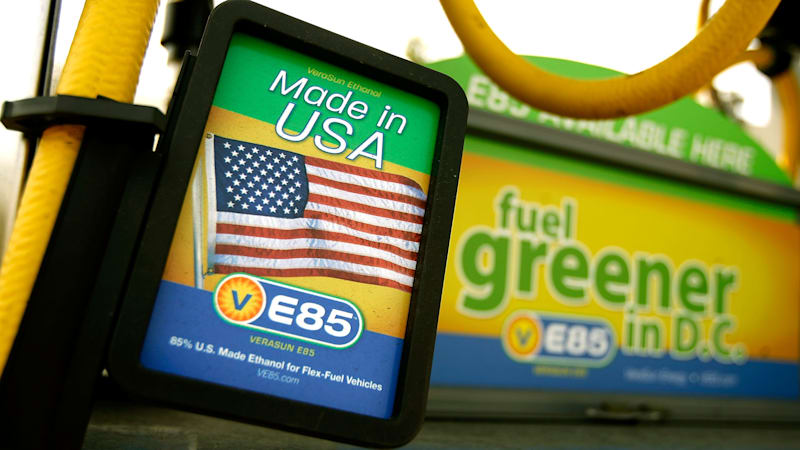What is Flex Fuel, and what do E10, E15 and E85 mean?

On the surface, Flex Fuel sounds like a great idea. It allows certain cars to run on various blends of gasoline and ethanol, a type of alcohol derived from crops like corn or sugarcane. Ethanol fuel came about as a response to oil shortages starting in the 1970s, but the technology didn’t really mature until the 1990s when some automakers, mostly from the Big Three, began introducing Flex Fuel vehicles.
How much ethanol is in Flex Fuel?
Specially equipped vehicles designated as Flex Fuel capable can operate on E85, a mix that’s as high as 85% ethanol and just 15% gasoline. However, to a lesser degree, nearly all cars are already using a gasoline-ethanol mix. Most gasoline sold at pumps in the U.S. could technically be E10, a 10% ethanol blend, though it isn’t always.
The EPA has also approved E15, a 15% ethanol blend. However, in 2012 a coalition of automakers pushed back against the proposal to increase ethanol content by 50%. The EPA deems E15 safe to use in 2001 and newer cars, but there has been conflicting research on whether or not it is damaging. Many automakers said at the time that they would not honor warranties if owners used E15.
Read more: What is E15 gas? Some FAQs answered
How to identify a Flex Fuel vehicle
Flex Fuel vehicles are designated by either a yellow fuel filler cap or a yellow ring on capless fuel tanks. They may also have labels on the inside of fuel filler doors, or special Flex Fuel badging on the vehicle. The U.S. Department of Energy offers a list of Flex Fuel vehicles on sale right now. Most are workhorses like the Chevy Silverado/GMC Sierra, Ford Transit Connect, Transit, F-150 and F-250. The Ford Explorer is the only standard family car currently on the list, though you can find some older, discontinued Flex Fuel cars on the used market like the Chevy Impala and Ford Taurus.
Flex Fuel pros
By stretching the amount of actual gasoline used, Flex Fuel seems like the perfect solution for extending a finite resource and reducing dependence on foreign oil. And since the ethanol was derived from renewable biomass, it was originally seen as a green solution as well.
In addition, E85 has an octane rating of about 110, higher than the 93 octane of premium fuel. That means the fuel can better resist earlier-than-expected combustion caused by compression and thus burns more completely, and a cleaner burn means fewer emissions at the tailpipe. While performance engines typically have higher compression ratios, the current crop of E85-compatible vehicles are not exactly sporting machines that can take advantage of the higher octane.
Read more: The latest news on today’s gas prices
Because Flex Fuels use less petroleum, they are cheaper. At the time of this writing, the national average for E85 is about 80 cents less than E10, the most common type of fuel. Prices will vary by region, so check your local listings.
Flex Fuel cons
It may seem like a no-brainer to use E85 if you have a Flex Fuel vehicle in times of high gas prices. However, it should be noted that ethanol reduces fuel economy (miles per gallon) by as much as 25% to 30%. Depending on the vehicle’s mpg rating and the local price of E85, drivers will have to determine for themselves whether the reduced fuel economy negates any potential savings at the pump.
Perhaps an even bigger problem is that E85 might not even be as great for the environment as proponents claim. In the U.S. most ethanol is derived from corn, and the corn industry has an immensely powerful lobby. Filling stations in states like Iowa, where corn is a major industry, have a lot more E85 available, often with stickers touting its claimed environmental benefits.
Read more: The latest news on ethanol
Over the years, powerful corn lobbyists have won a lot of government subsidies, which in turn prompted many producers to grow the crop even though, according to a Stanford University study, corn-based ethanol is five to six times less efficient to produce than sugarcane-based ethanol.
Another study in the Proceedings of the National Academy of Sciences found that after taking into account the increased clearing of land to grow corn for ethanol production, the environment would be better off if cars just burned straight gasoline. And then there’s the fact that we’d be better off using the resources corn takes up to grow crops that feed actual people. Ethanol would be most beneficial if it could be economically made from biomass that would otherwise be discarded, like corn stalks and other cellulosic sources.
Should I use Flex Fuel?
If your vehicle wasn’t built as a Flex Fuel vehicle, do not use E85. The high ethanol content will damage vital engine parts and the fuel system. As we mentioned above, it’s probably best not to risk using E15 if you have an older vehicle or are unsure if it’s compatible in your car.
Read more: The latest news on biofuels
Does ethanol damage cars?
Many sources, including the U.K.’s Royal Automobile Club, say that even E10 can be damaging to cars older than the 2002 model year. Ethanol is corrosive, and its use can damage fuel systems that weren’t designed for anything other than pure unleaded gasoline. Fuel tanks, gaskets and seals, and other rubber or plastic components could all be subject to damage.
It’s not a guarantee of damage, and how susceptible your vehicle is will likely depend on the age and model. If this is a concern for classic car owners, they can either use an ethanol conditioner and stabilizer or find one of the few remaining gas stations that offer ethanol-free fuel.
Related video:




